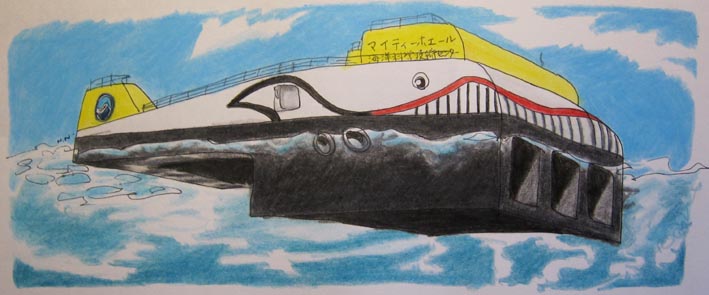波力発電について
浮体式波力発電装置「マイティホエール」
 拡大画像
拡大画像
画像は海洋科学技術センター (JAMSTEC/現・海洋研究開発機構) が開発した浮体式の
波力発電装置「マイティホエール」である。[拡大画像: x25429.jpg: illustrated by Nagisa Nakauchi][To be continued]
http://www.jamstec.go.jp
以下、作成中です
波力発電の開発可能性
高さ2mの波は海岸10km当たり24万キロワットのエネルギーをもつといわれる。それは大規模水力発電所に匹敵する。
益田善雄氏による先駆的開発: マスダ・タービン、波力発電装置の開発パイオニア。1965年、波力発電開発の歴史の中で画期的な発明といえるマスダ・タービンが完成した。これは4つの弁をもつ空気タービンで、波が上下するたびに逆流する空気の流れを一方向の流れに調整する機能をもつ。このタービンは航路標識のブイに取り付けられ、100ワットの電気を発電し、海に灯ををともすことに成功。世界ではじめて波力発電を実用化した。
1998年、日本は、三重県・五ケ所湾で、浮体式波力発電装置「マイティ・ホエール」の実験を開始。浮体式とは、海上に実験装置を浮かべ、チェーンで改訂に固定するやり方。
「ウェルズ・タービン」が搭載されている。幅30m、長さ60mの浮体の中に、3つの同タービンを設置。実験は1998秋に開始、
ポルトガル領アゾレス諸島のピコ島に波力はつでんプラント建設中。ポルトガルから約1500km西の大西洋にあるでの実験。EUの波力発電プロジェクト実施中。これは「第2次ジュール計画」の一環として進められている。原理は、荒々しい岩場の海岸に12m四方の空気室チャンバー。ちょうどコップを海面に少し伏せた状態、波が押し寄せてきて、コップの中の水面が上に押し上げられる室内の空気圧力が高まる。波が引くと空気は下がる。波の上下運動を空気の圧力に変換する。波の直接打ちつけるパワーを利用するのではなく、上下運動を空気のエネに変換し、圧力が高まった空気でタービンを回転する。タービンは直径2、4m。正常な作動では秒速40mの風=空気流がチャンバーから吹き出し、タービンに導かれる計算。それが、タービンを回転させ、出力400キロワットの発電機を動かす計画。海岸に固定された方式である。装置は1999年夏には稼動開始予定。研究用のプロトタイプ=試作機であるが、島内配電網に接続、電力供給予定である。
離島では多少はつでんコストが高くても採算にあう。他のはつでんとのコスト非核。コストダウンを目指して経済的競争。
今後、英国・スコットランドのアイラ島で波力発電プラント建設プロジェクトが開始予定。
ウェルズ・タービン:英国アラン・ウェルズ博士が1976年発明したもの。タービンの羽根に工夫が施され、空気流の向きが変わってもタービンは常に一定濃厚に回転する画期的なもの。
1992年、国連環境開発会議開催(ブラジル・リオデジャネイロ)
基本的に日本は波力エネルギー開発に有利な自然条件をもつ。その相対的長い海岸線
大まかな推定によれば、海岸線Km当りのエネルギーは .
電力に転換されるものは、波の水平、垂直運動、或いはそれによる海中の圧力変化である。例えば発電機を高速で回転させるには、その回転を加速するために何等かのケカニズムが要求される.
酒田での実証試験/2000watts-class
発電原理
開発の系譜
General Remarks 序説
. The ocean, a huge reservoir of salt water and a single largest unity on the earth, can be also recognized as
a huge reservoir of energies. It contains energy potentials in a variety of forms: for instance, wave, tide,
current, heat, salinity and etc. The energy potential in any form is extremely enormous as shown in Figures.
. In any form, however, the energy density is extremely low. For any type of of energy convertion, therefore,
extremely enormous amounts of sea waters would be required to be transacted one time as a bigger output is expected.
. In today's Japan, except for quite limited cases, power generation through ocean energy convertion is not
economically practical/feasible, even though technologically possible. Nevertheless, Japan has been increasingly
deeply involved in the R/D on ocean energy convertion while challenging further diversification of other energy
resources.
. Japan is surrounded by seas. Therefore it might be said in general that Japan has natural conditions favorable
to ocean energy development. Ocean energies are produced domestically, while not depending on other nations'
resources. Ocean energy resources also exist in inexhaustible quantities, not wasted away. OEC technology would
also provide Japan with a certain bargaining power. while easing its vulnerability due to energy shortages.
海洋エネルギー開発[総論]
海洋はエネルギーの巨大な溜池である。様々の形態でエネルギーポテンシアルをもつ。波、潮汐、海流、熱、塩分。
何れの形態であれそのポテンシアルは極めて巨大である.
Wave Energy Development 波力発電
. Basically, Japan has several natural conditions favorable to wave enrgy development: its relatively longer coastlines,
totalling approx. 34,000 km and its location in the periodic wind zone.
. The formula of estimating wave energy potential per metre of coastline is . According to a rough estimation,
megawatts per annum are dissapeared throughout its entire coasts.
. What are converted to electric power are; wave's horizontal and vertical movements, or underwater pressure's change
caused by them. Waves are moved at a slow velocity despite having strong forces. For instance, for rotating a generator
at a higher speed, a certain mechanism is required to accelerate the rotation. Their movements are eciprocating往復運動.
Furhtermore, they considerably change with seasons and the passage of time. Therefore, the output becomes inevitably
instablized.
OTEC, Ocean Thermal Energy Convertion 温度差発電
Tide and Tidal Energy Development 潮汐・潮流エネルギー開発
tidal power 潮力発電
Ocean Current Energy Development 海流エネルギー開発
As to this type of energy development in Japan will be referred to in the future edition.
Sea-water Pumping -up Power Plant/Statation 海水揚水発電
Principal concept of a pumping up power generation system is: pumping up of freshwater or seawater to a reservoir
by using surplus power and generationg power at time when power demand is sharply increased.
On July 1987, Dengen Kaihatsu announced a project of construction of a pilot plant of seawater pumping up power plant.
According to the plan, a 30,000Kw-class pilot plant inOkinawa Island by 1992 FY and make operation tests for
5 years(1993-97 FY).
揚水発電の基本概念は:余剰電力を利用して水(淡水、海水)を貯水池に汲みあげ、電力需要の急増時に発電する方式。
電源開発は1987年7月、世界で初めて、沖縄にて、海水揚水発電の実証試験を行うと発表. 1992年度を目途に出力30,000Kwの
パイロットプラントを建設し, 1997年度までの5年間発電運転試験を実施する.
 このページのトップに戻る
/Back to the Pagetop
このページのトップに戻る
/Back to the Pagetop
[2017.02.26 記]